48 results
High school chemistry literature circles for Montessori
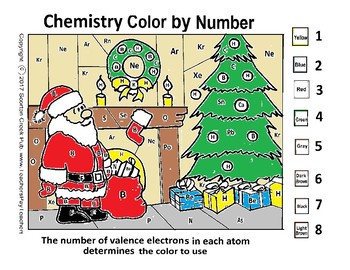
Christmas Chemistry Color by Number - by Valence Electrons
Solve each chemical element for the number of valence electrons indicated by its atomic mass and use that answer to determine the color of each section. For example hydrogen has 1 valence electron so wherever you see "H" use the number color 1 which is yellow.
Grades:
6th - 12th, Higher Education, Adult Education, Staff
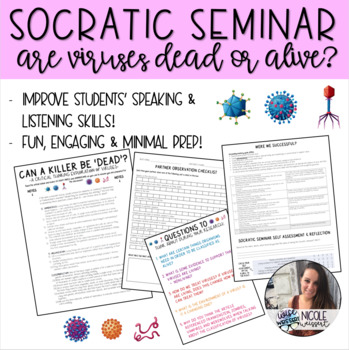
Science Socratic Seminar - Are Viruses Dead or Alive?
This product is designed to improve students' speaking and listening skills in a science classroom while pushing them to analyze a scientific text. In science, there is more and more debate on whether or not viruses are considered living or non-living which gives us the opportunity to push our students to use this topic as conversation in the classroom. This product includes:- A text (source cited on page)- bigger thought provoking questions- instructions for students to create their own questio
Subjects:
Grades:
6th - 10th
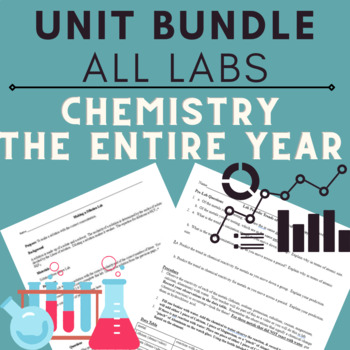
BUNDLE: High School Chemistry Labs -- THE ENTIRE YEAR for Every Unit (41 Labs!!)
Outline of each Unit to Lab Match:Introduction: Scientific Method LabIntroduction: Accuracy and Precision LabConversions: Converting Everyday Objects.Conversions: Conversion Version 2 - Using your own conversion factors.Matter & Changes: Density LabMatter & Changes: Mixture Separation Chromatography LabMatter & Changes: Physical and chemical Changes LabThe Atom: Isotope Activity/LabThe Atom: How Thick is Aluminum Foil? LabThe Atom: Online Atom Builder LabNuclear: Iodine Clock for Dec
Subjects:
Grades:
8th - 12th, Higher Education
Types:
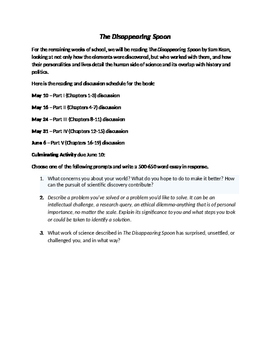
The Disappearing Spoon - A Chemistry Literature Unit
For the past few years after my students finish the AP Chemistry exam early May, I have had my students read "The Disappearing Spoon" by Sam Kean - a book that talks about the elements and the scientists who discovered and created them in a really fun, creative, humanizing way. The book is in five parts, so I have my students participate in five Socratic seminar-style class periods (90 minutes each) with these discussion questions to guide the conversation. I put my desks in a circle, and they c
Subjects:
Grades:
9th - 12th
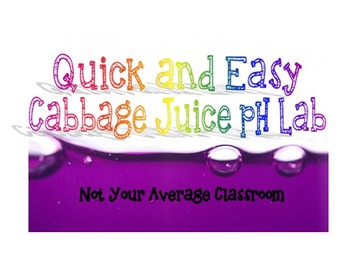
Quick and Easy Cabbage Juice pH Indicator Lab
This activity results in impressive color changes and is really fun to do! Students will use cabbage juice to test various substances for acidity or alkalinity. Purple cabbage juice turns bright pink for acids and bright blue for bases. This lab lists vinegar, tap water, baking soda solution, lemon/lime soda, and bleach solution - but you can easily convert the file to a word document and edit as needed.
This is a completely qualitative lab, and it is meant to be done in very little time. The ac
Subjects:
Grades:
5th - 12th
Types:
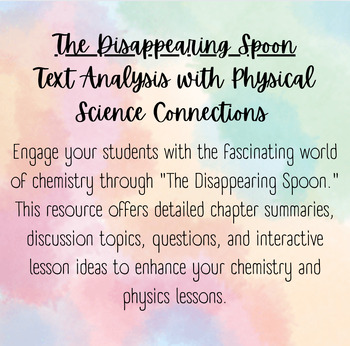
Comprehensive Text Analysis and Discussion Guide for "The Disappearing Spoon" by
Overview: Dive deep into the fascinating world of chemistry with our comprehensive text analysis and discussion guide for "The Disappearing Spoon" by Sam Kean. This resource is designed for high school science educators looking to enhance their chemistry and physics lessons by connecting them to the captivating stories and scientific principles presented in the book.Product Highlights:Detailed Chapter Summaries: Each chapter is summarized to highlight key concepts, scientific discoveries, and hi
Grades:
8th - 12th
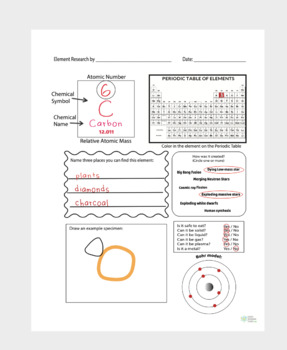
Element Research Portfolio
Everything your students need to make research portfolios all about the elements. Includes a cover page to decorate and a double-sided worksheet to guide research (I listed our favorite books and free websites) as well as a periodic table that shows where the elements come from to make completion simple and straight-forward. Use the included blue-lined, Montessori style paper to write favorite facts (or use your own paper style if preferred). Makes for wonderful student-lead learning & Mont
Subjects:
Grades:
1st - 9th
Types:
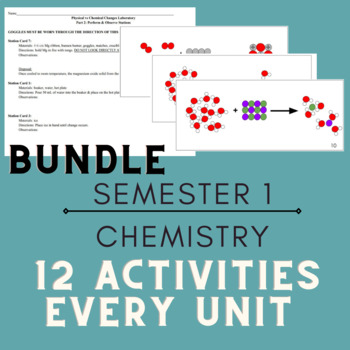
BUNDLE: High School Chemistry Semester 1 Activities (Every Unit- 12 Activities!)
Outline of each Unit to Activity Match:*computers Required for 4 activities!!*Introduction: Equipment IdentificationMatter & Changes: Tricky Mixtures StationsMatter & Changes: Physical vs Chemical Particle Diagram Identification x 2The Atom: Online Atom Builder Nuclear/Radioactivity: 1 Day Poster Research ProjectElectrons: Bohr Models & Electron Configuration RelationshipsElectrons: BattleshipPeriodic Table: Coloring Groups/FamiliesChemical Bonding: Building Molecules with Model Kits
Subjects:
Grades:
8th - 12th, Higher Education
Types:

LAB Chemistry Density of Pennies - with Graphing & Demos
Engage your chemistry students by having them determine the composition of pennies as it changed over time. Students will chart & graph their results. After, you can demonstrate and prove that pennies are made of zinc internally.Included:3 page Student worksheet with procedure, chart, graph & analysis questions1 page teacher density demonstrations (5 easy options)Materials: pennies 13 pre 1982 & 13 post 1982 (per group or 1 set every two groups & switch pennies)graduated cylinder
Subjects:
Grades:
4th - 12th, Higher Education
Types:
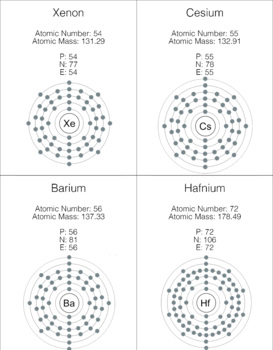
Elements of the Periodic Table Electron Orbitals
Element cards with electron orbitals, number of protons, neutrons, and electrons, name of elements, and element symbol. Use these cards to further explore atoms, subatomic particles, and elements of the periodic table.These are not three part cards, but can easily be made into three part cards by cutting the name off the top.
Subjects:
Grades:
1st - 10th
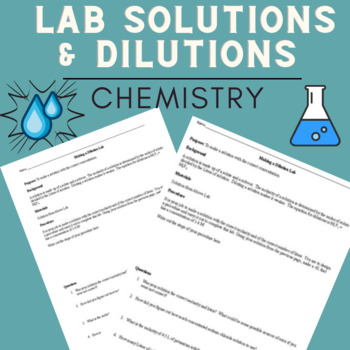
LAB - Chemistry - Make a Solution & Dilution - Easy Materials! - With KEY
This lab has students write their own procedure to make a solution and dilution with teacher observation & testing. This inquiry-STEM activity is great to get students thinking and engaged. Even some of the smartest students fail to connect Molarity to physical performance. This lab allows for that connection.I usually use a pH strip to test their solutions and dilutions! pH probe is better as well.materials:solute - the KEY is with citric acid, but any can be used.BalanceGraduated Cylinderb
Subjects:
Grades:
8th - 11th
Types:
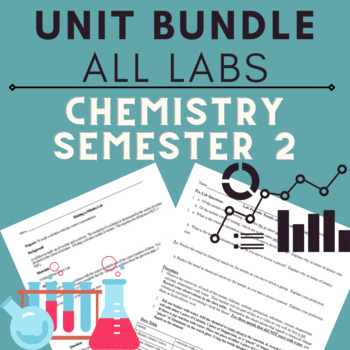
BUNDLE: High School Chemistry Semester 2 Labs; Labs for Every Unit (20 Labs!!)
Outline of each Unit to Lab Match:Moles: Chalk Name & Body LabMoles: Molar Volume ConversionStoichiometry: Decomposition of Baking Soda LabLimiting Reactants: Limiting Reactant LabGases: 8 Stations Gas LawsGases: Exploring Variable Relationships (online)Gases: DiffusionGases: Gas Stoichiometry DesignSolutions: Properties of WaterSolutions: Calculate MolaritySolutions: Make a Solution & DilutionSolutions: Make Ice CreamAcids & Bases: pH of common materialsAcids & Bases: Mini Soda
Subjects:
Grades:
8th - 12th, Higher Education
Types:
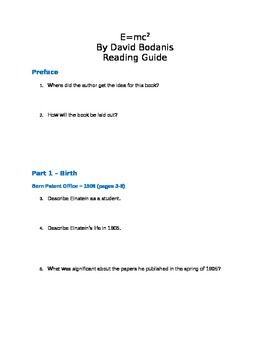
E=mc2 by David Bodanis Student Reading Guide
Introducing literacy into the content areas is a best practice in today's high school science classroom. This reading guide is designed to be used by students reading E=mc2, A Biography of the World's Most Famous Equation by David Bodanis. There are over 150 questions written by me, a high school physics teacher, designed to help my physics students understand the author's point of view as we read this book in class next year. Questions are chronological and in short answer format. Answer key
Subjects:
Grades:
9th - 12th
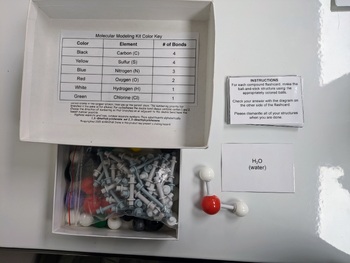
Covalent Bond Modeling Flashcards
Turn a molecular modeling kit into a classroom set of covalent bond practice!This document includes a color key for the balls in the kit, a set of 12 flashcards with molecule name on one side and the ball-and-stick model answer on the other, and an instruction card. I use this as Montessori shelfwork in my classroom.
Subjects:
Grades:
9th - 11th

Properties of Matter Sorting / Classification Cards, with Definitions
These sorting cards provide a fun, hands-on activity to help students practice their understanding of the properties of matter. Students match a definition card to each label heading, then check their answers. Next, they sort the cards below the headings, determining whether each property of matter is an extensive physical property, an intensive physical property, or a chemical property of matter. The set includes category labels, definition cards for matching to the labels, error control car
Subjects:
Grades:
5th - 9th
Types:
NGSS:
5-PS1-3

Parts of a Plant Cell 3 Part Cards Montessori Nomenclature Botany
Montessori's Classified Cards are well-known and loved because they are a great way to help your child learn to read. This resource is included in Zoology Unit 1: Basic Introduction to Living Organisms - click here for that resource.⭐⭐⭐3-Part Cards Parts of a Plant Cell Montessori⭐⭐⭐Save yourself hours of work. All you have to do is download the PDF, cut out the cards and labels, and you are all ready to go! The following is included:16 pictures with labels in type font (approximately 3½ x 3¼) 1
Grades:
1st - 9th
NGSS:
MS-LS1-2
Also included in: Living Nonliving Bundle eLearning and Printables Montessori Zoology

LAB Chemistry - Nuclear Decay - Wet Lab
Engage your chemistry students by having them performing an iodine clock reaction -- reimaged to be assigned to nuclear decay! Students will time the clock, graph the results and imagine how the nucleus decays over time.Included:1 sheet Lab 2 pages1 Sheet teacher solution creation directionsObjective: Observe and determine the equilibrium shift of the reactionMaterials Students:• Solution A• Solution B• 2 Erlenmeyer flasks• 3 graduated cylinders • A magnetic stirrer (if available) Timer• Beaker•
Subjects:
Grades:
8th - 12th, Higher Education
Types:

LAB Chemistry - Equilibrium Le Chatlier's Principle
Engage your chemistry students by having them performing an equilibrium shift. This lab is empowering because students can SEE the shift right before their eyes. This lab does require quite a bit of set up, but is well worth the effort.Included:1 sheet Lab 2 pagesObjective: Observe and determine the equilibrium shift of the reactionMaterials test tube tongs droppers0.1 M &g Iron (III) Nitrate 0.1 M KSCN 0.1 M NaOH 0.1 M Silver Nitrate 0.5 g KClWater 7 Test Tubes Test Tube Rack Stirring Ro
Subjects:
Grades:
8th - 12th, Higher Education
Types:
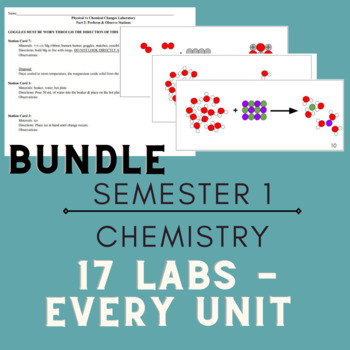
BUNDLE: High School Chemistry Semester 1 Labs; Labs for Every Unit (22 Labs)
Outline of each Unit to Lab Match:Introduction: Scientific Method LabIntroduction: Accuracy and Precision LabConversions: Converting Everyday Objects.Conversions: Conversion Version 2 - Using your own conversion factors.Matter & Changes: Density LabMatter & Changes: Mixture Chromatography LabMatter & Changes: Physical and chemical Changes LabThe Atom: Isotope Activity/LabThe Atom: How Thick is Aluminum Foil? LabThe Atom: Online Atom Builder LabNuclear: Iodine Clock for Decay LabElect
Subjects:
Grades:
8th - 12th, Higher Education
Types:
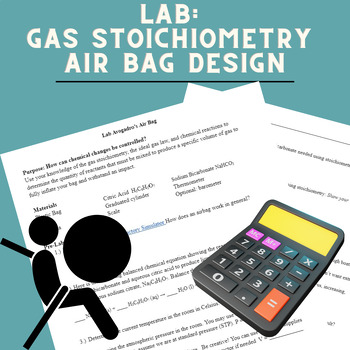
LAB Chemistry Gas Stoichiometry & Gas Laws - Design an Air Bag
Engage your chemistry students by having them observe and perform an inquiry experiment using gas stoichiometry & gas laws to design their own airbag.Be sure to test them by dropping items upon them!MaterialsCitric Acid H3C6H5O7 (grocery)Sodium Bicarbonate NaHCO3 (grocery)Water Graduated cylinderScoopula Plastic Baggies with sealThermometerScale
Subjects:
Grades:
9th - 12th, Higher Education
Types:

SI Units Matching Activity for Chemistry
This activity is an easy way to have your students improve their recognition of SI units by matching the physical quantity, unit name, and symbol of the seven fundamental units. In my classroom, I laminate it to have a class set to use as Montessori shelfwork. This file includes 3 pages:Blank table to fill inCards to cut outAnswer key
Subjects:
Grades:
9th - 11th
Types:
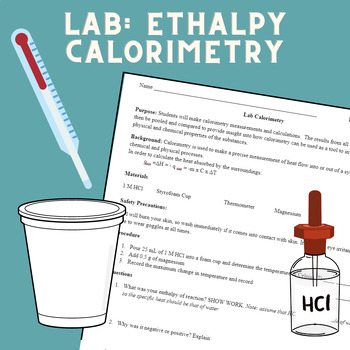
LAB Chemistry Simple Calorimetry (Heat & Enthalpy)
Engage your students by having them observe and perform a small scale calorimetry experiment.Objective: Students will make calorimetry measurements and calculations. The results from all students can then be pooled and compared to provide insight into how calorimetry can be used as a tool to investigate the physical and chemical properties of the substances.Materials1 M HCl Foam CupThermometerZinc OR MagnesiumCalculator
Subjects:
Grades:
9th - 12th, Higher Education
Types:
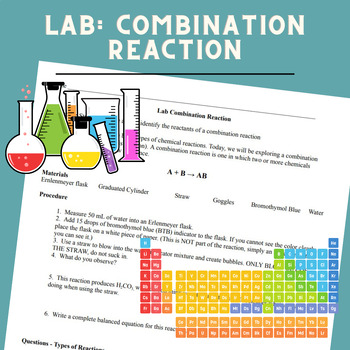
LAB Chemistry - Easy Combination Reaction
Engage your chemistry students by having them perform a quick combination reaction, with a fun color change. This gets students up and moving with easy setup & safety measures. They will write out a full equation for the reaction observed (problem solving) as well as a quick balancing practice.Objective: Observe and predict the reactants of a combination reactionMaterials:Erlenmeyer flaskGraduated CylinderStrawBTB (bromothymol blue) Water
Subjects:
Grades:
7th - 12th, Higher Education
Types:
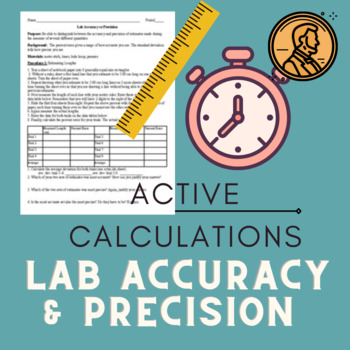
LAB Accuracy and Precision - Kinesthetic, Engaging, and Calculation Practice
Time: 50 minutesMaterials: Rulers, timers/stopwatches/computer for stopwatch, Pennies, & A target (hula hoop, tape on the floor)
Subjects:
Grades:
8th - 11th
Types:
Showing 1-24 of 48 results





